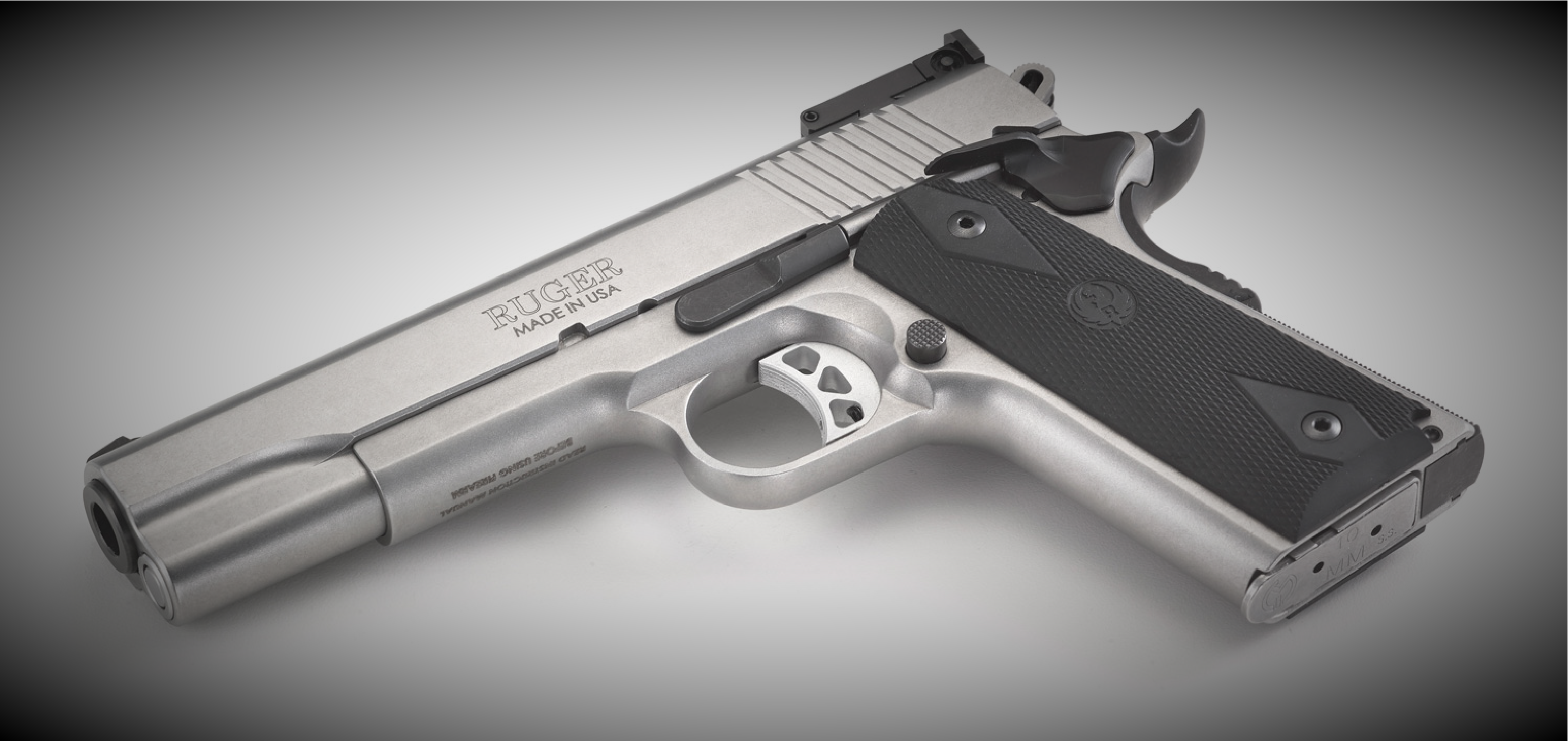
While the 10 mm cartridge’s place in life still escapes me, I still wish to pursue it. I had reviewed the Springfield XDM-10 5.25 in this caliber. While the XDM is a fine pistol, a contention of mine is to have a 1911-based pistol that would fire the same caliber. The dark recesses of my mind say that if a pistol caliber cannot be shot out of a 1911-based pistol, it is not worth the bother.
Of the 10mm 1911-based pistols, I Have investigated the Rock Island Armory ROCK Ultra FS – 10mm (51991), a 10-round version, and the ROCK Ultra FS HC – 10mm (52009) that is a double-stack, 16-round pistol. I have also researched the Dan Wesson 1911 10mm Firearms, Glock, Springfield Armory (TRP ), Kimber Manufacturing, Nighthawk Custom, Smith & Wesson, STI International, Armscor, and Tanfoglio. In 2015 SIG Sauer entered the 10mm marketplace with their P220 model chambered in 10mm. Ruger introduced a 10mm auto model to their popular SR1911 line in mid-2017, followed by their Blackhawk, Redhawk, 10mm GP100 Match Champion, and Wiley Clapp models in 2018. Springfield Armory began 2019 by producing a XDM chambered in 10mm. There is the Remington R1 10mm Hunter Long Slide, and of course the Colt Delta Elite.
I always had a visceral reaction to the Colt Delta Elite, as I did with the L.A.R. Grizzly Win Mag chambered in .45 Winchester Magnum. The Colt Delta Elite chambered a cartridge that was still in its infancy, and I think that is why the Colt Delta Elite did not perform as well as was expected. Everyone, it seems, may have under-estimated the 10mm cartridge and its impact on auto-loading pistols. The battering of the Colt Delta Elite pistol was a true indication of 10mm power. The 10mm and the Colt Delta Elite went to the back of the room. The Colt Delta Elite; however, is back among us after being discontinued in 1996. Colt announced the re-introduction of the Delta Elite at the 2008 SHOT Show. The 10mm Auto cartridge is experiencing a resurgence of interest (as is the 9mm cartridge), and now perhaps will be recognized for the fine cartridge that it is. My only question, at this point, is where the 10mm cartridge fits in my grand scheme of things.
I’ll not go into the history of the 10mm Auto cartridge, as that is well-known by most (by now). However, if you must understand why the cartridge became a focal point of certain federal law enforcement agencies knee jerk reaction to getting their butt’s kicked, a link to the 1986 FBI Miami Shootout can be opened by clicking here. But, let’s get back to the launching pad for this now ubiquitous cartridge.
The 10mm cartridge is a hot performing cartridge with a maximum case pressure in the 37,500-psi range. There is no doubt that when the cartridge is fired through a 1911-based pistol, the pistol had better be capable of handling this cartridge. Longevity of the launching platform is a definite issue, because we know that the more a weapon’s platform is battered, the greater the failure likelihood of that platform. The choice of a launching pad for the 10mm cartridge is a cost vs. benefit conundrum.
At an MSRP of $1299.00, the Colt Delta Elite is enticing; more so than the Springfield Armory TRP at an MSRP of $1,790.00 for the non-RMR model. For a hunting application, a long-slide model like the Remington R1 10mm Hunter ($1,310 MSRP) with a 6-inch barrel might be the ticket. For personal defense, a 5-inch barrel may be enough (in most cases) where an uploaded cartridge may be used against furry woodland creatures who are looking for a meal, and you happen to be it, or a downloaded cartridge against two-legged predators who are looking to eat your lunch. The 10mm cartridge does offer both worlds in one platform; whereas, cartridges like the 9mm and .45 ACP are primarily intended as self-defense cartridges only.
Of course, there is the “other” route one can take to achieve 10mm Auto status by indulging in a polymer pistol such as a Glock G20 (4.6” barrel and an MSRP of $695), a Glock G40 (6” barrel with an MSRP of $840), or a Springfield XDM-10 5.25 (MSRP $779). But, since you are reading this article expecting information on the Ruger SR1911 10mm, that tells me that you are interested in taking a more traditional (wood and steel) approach to the caliber 10mm.
Of the 1911-based pistols available for the 10mm, I had to make a facultative decision with myself to invest in another 10mm firearm (I like redundancy). The firearm would be primarily for self-defense. As such, full hunting loads would not be needed in the environment that it would be operating, but personal defense loads would be, if called upon. So, let’s talk about the chosen platform.

In 2011 Sturm Ruger and Company introduced it version of the time-tested 1911 pistol, a first for Ruger and for us, as it was questioned many times before then why Ruger was not building a 1911. Well, Ruger finally got a Round TUIT and soon versions of “Government,” “Commander,” Lightweight Commander,” and “Officer” model soon hit the shelves in two calibers; .45 ACP and 9mm. The Ruger SR1911 series has been well received by the shooting community and it was only a question of time that Ruger would add another caliber to the SR1911 line-up; but what caliber, 40 Smith & Wesson or 10mm Auto?
Possibly seeing the writing on the wall, Ruger decided not to invest in a .40 Smith & Wesson version of the SR1911, but instead introduced a 10mm version. The 10mm version, along with the “Officer” version in .45 ACP is so new that Wikipedia has not yet picked up on them.
The specifications and features for the Ruger SR1911 in 10mm are shown below.
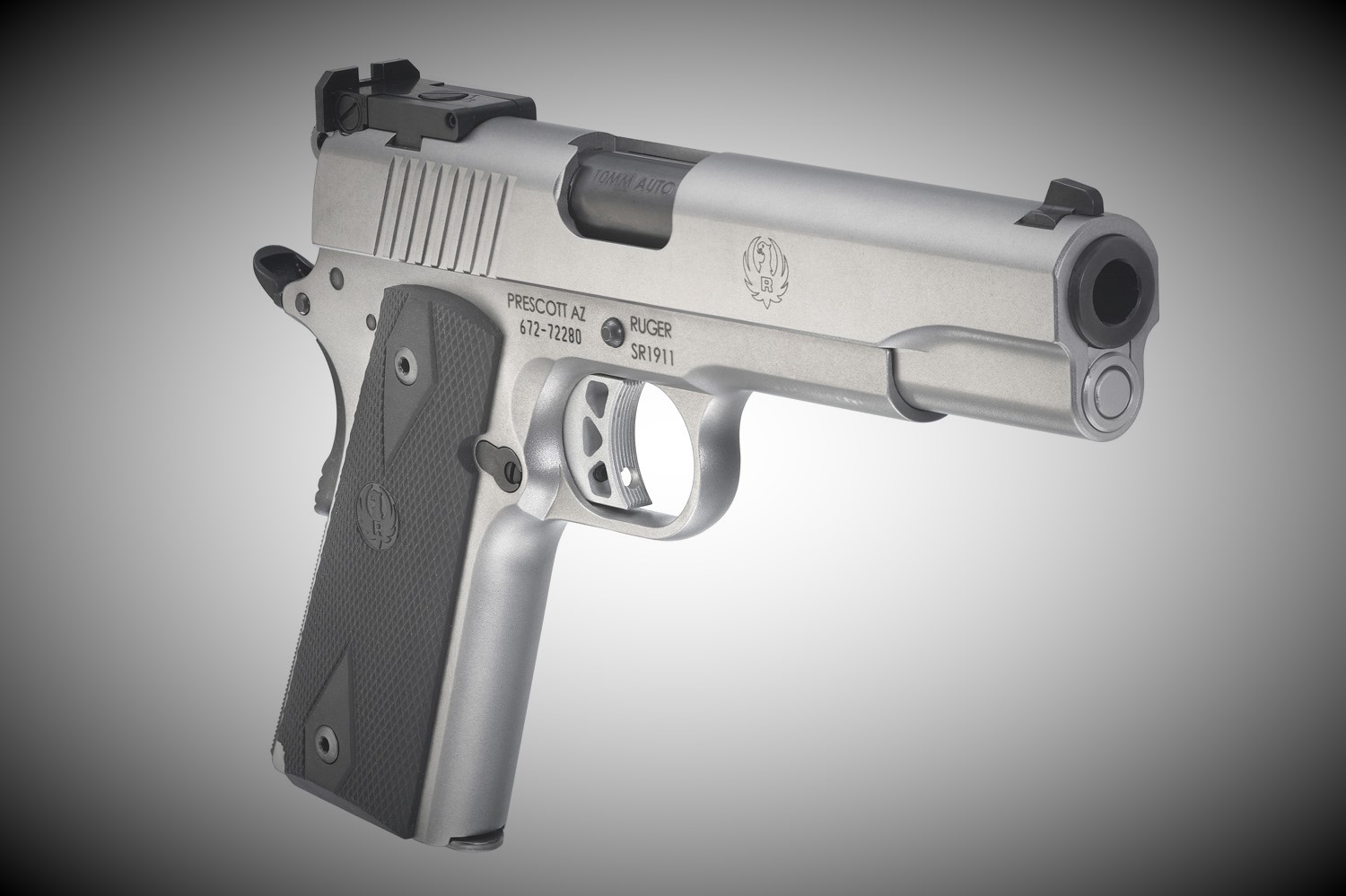
Specifications
| Capacity | 8+1 |
| Slide Material | Stainless Steel |
| Barrel Length | 5″ |
| Grip Frame | Low-Glare Stainless |
| Grip Panels | Black Rubberized |
| Model Type | Target |
| Slide Finish | Low-Glare Stainless |
| Width | 1.34″ |
| Sights | Adjustable Target |
| Weight | 40.4 oz. |
| Overall Length | 8.67″ |
| Height | 5.45″ |
| Grooves | 6 |
| Twist | 1:16″ RH |
| Available in CA | No |
| Available in MA | Yes |
| Suggested Retail | $1019.00 |
Features
- Classic, original 1911 fire control.
- Precision CNC-controlled machining process results in a superior slide-to-frame fit and smooth slide travel.
- The black bushing-less stainless-steel bull barrel provides additional weight at the muzzle for improved recoil control, aided by a full-length guide rod.
- Positive barrel lock-up allows for superior accuracy out of the box.
- Traditional design with replaceable grip panels and checkered backstrap.
- Skeletonized hammer and titanium firing pin for faster lock time.
- Oversized beavertail grip safety provides positive function and reliability.
- Extended thumb safety and slide stop lever for improved, positive manipulation.
- Integral plunger tube for slide stop and thumb safety is not staked and will never come loose.
- Oversized ejection port and extended magazine release enhance performance.
- Inspection port allows for visual confirmation of a loaded or empty chamber.
- Features a flat mainspring housing and rear slide serrations for a positive grip.
- Accepts most standard, aftermarket 1911 parts and accessories.
- Also includes two stainless steel 8-round magazines.
Making a Case…
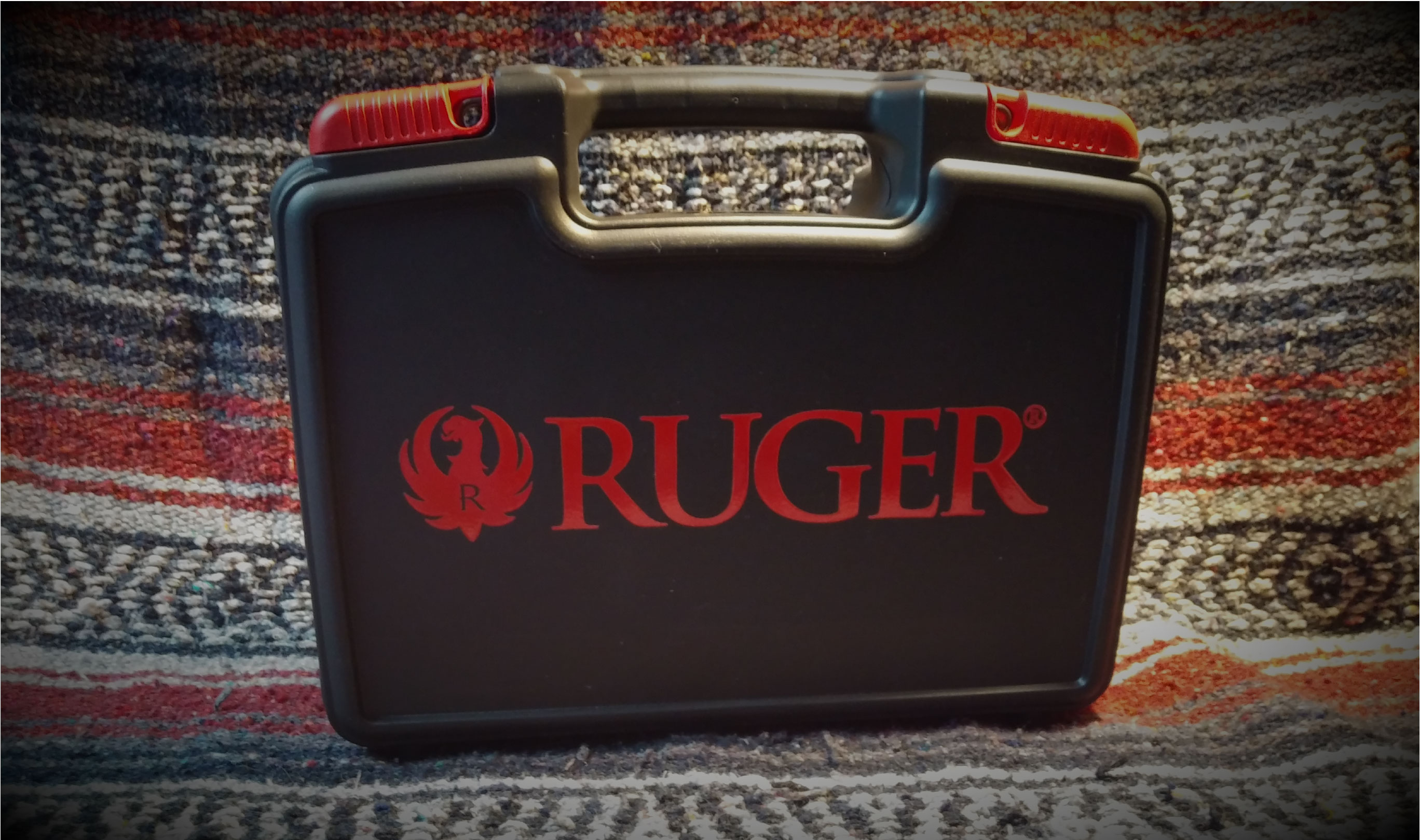
Before I overlook this, I need to mention the storage container that this pistol came in. If you have previously purchased a Ruger SR1911, you are used to the standard Ruger cardboard box. This pistol came in one of the better polymer cases that I have ever run across. I was (and am) so impressed by this container, I just must give it some time of its own.
The case is a black polymer lockable case with red locking tabs and the Ruger eagle and Logo on the top of the case, which is also in red (Ruger Red?).
Opening the case reveals a molded polymer removable tray that holds the SR1911, magazines, supporting documentation, lock, chamber flag, and disassembly tool.
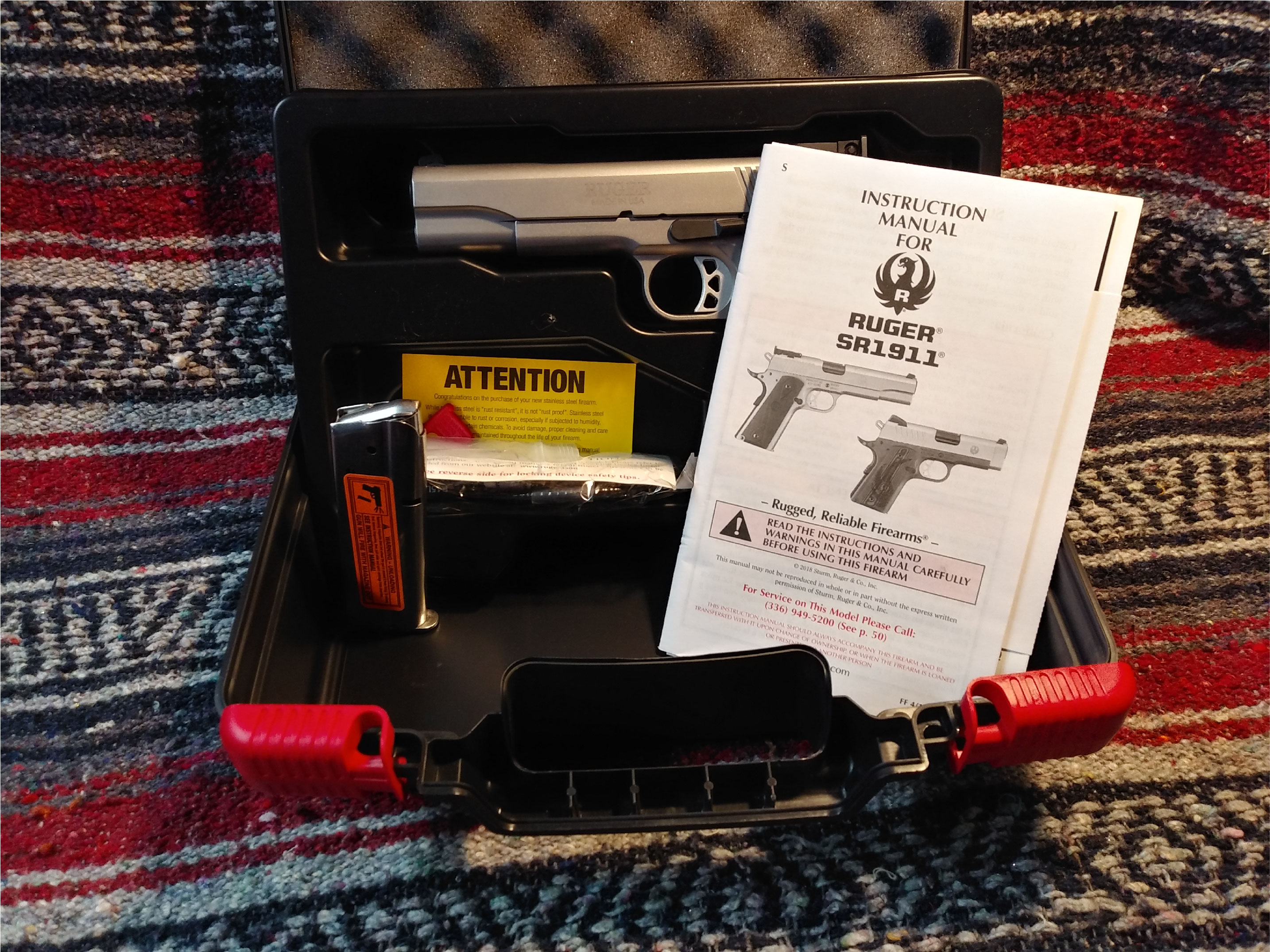
Impressive Carrying/Storage Case
By far, this has been one of the nicest carrying/storage cases that I have seen for a production pistol.
Spotlight on the Pistol
My research into the Ruger SR1911 in 10mm Auto has revealed not one negative thing about the pistol. I do not consider someone’s personal preference a negative. I also do not consider things like the pistol recoiling hard in the hand, or the shooter not being able to reach a certain control as a negative, as these are personal issues and not a fault of the firearm.
The Ruger Model Number: 6739, 10mm Auto looks to be the same as any of the other SR1911 pistols in the same barrel length, as shown below with the Ruger SR1911 Target 9mm Model Number: 6759. However, the Ruger Model Number: 6739, 10mm Auto does depart from the others a bit.
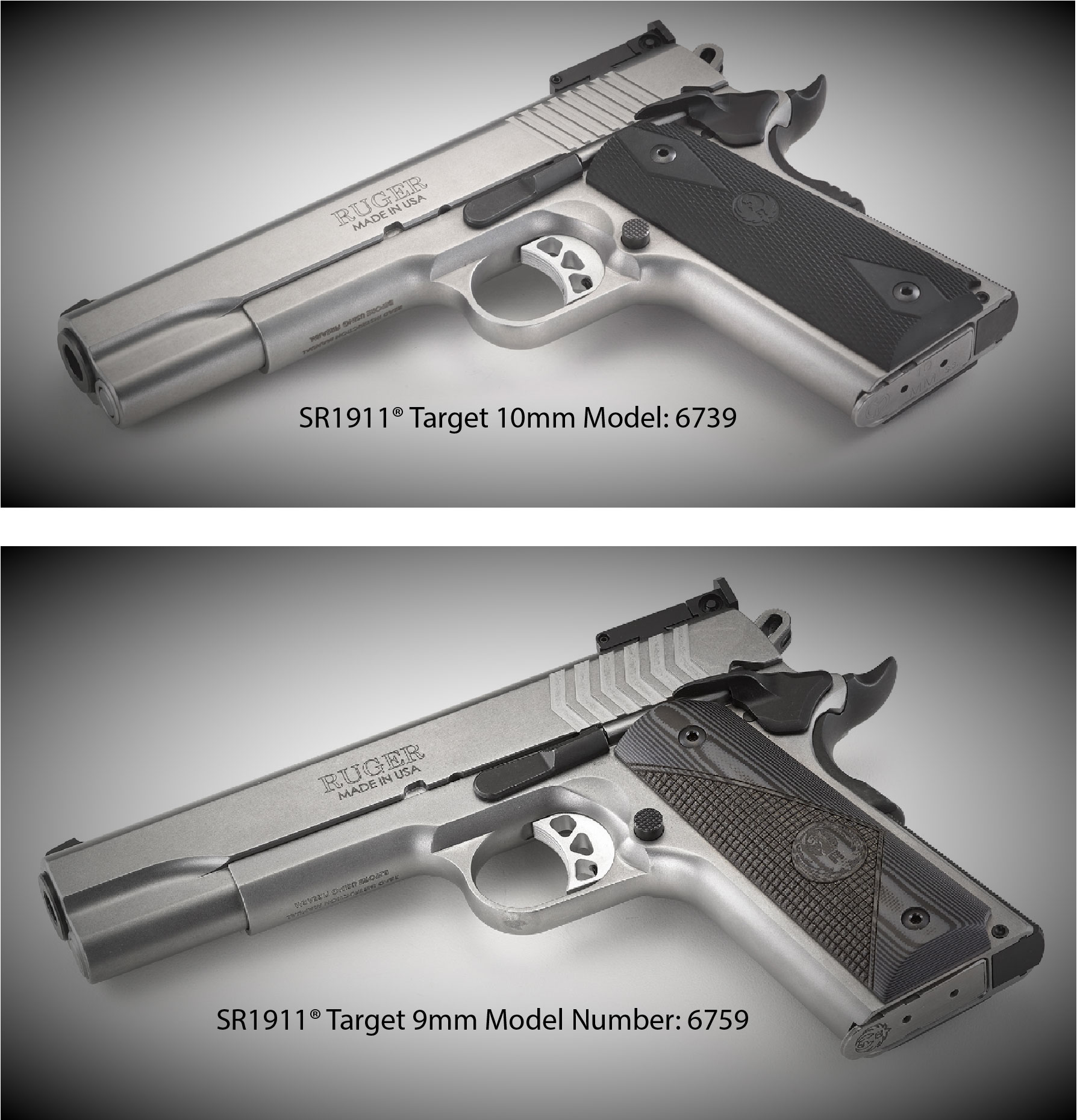
Like the 9mm version of the SR1911, the 5-inch stainless-steel, nitride-coated ‘bull’ barrel is of the bushingless type, and the stainless-steel guide rod is the one-piece full-length type with internal guide rod bushing. The recoil spring of the 10mm version; however, associates with an 18-pound recoil spring. The black bushing-less stainless-steel bull barrel provides additional weight at the muzzle for improved recoil control. Given the weight of the pistol at 40.4 ounces unloaded, the sharp felt recoil of the 10mm cartridge is not any more bothersome than most .45 ACP ammunition; however, a full-hunting load felt recoil is greater but still controllable.
Some recommended ammunition is shown below, with my preferred carry and range load in bold font:
- Hornady 175-grain Critical Duty – 1,160 fps
- Speer 200-grain Gold Dot – 1,100 fps
- SIG Sauer 180-grain V-Crown – 1,250 fps
- Federal 180-grain Hydra Shok – 1,030 fps
- Federal 180-grain Trophy Bonded JSP – 1,275 fps
- Buffalo Bore Heavy Outdoorsman 220 grain – 1,200 fps
- Hornady 180-grain XTP – 1,275 fps
- Underwood Ammo 150-grain Xtreme Hunter – 1,425 fps
- Remington 180-grain UMC FMJ – 1,150 fps
- Sellier & Bellot 180-grain FMJ – 1,164 fps
The slide and frame are finished with the satin appearance and black controls, barrel, sights, a two-tone skeletonized hammer, and grip provide contrast.
The barrel is a Wilson/Nowlin type “bull” fully-ramped barrel that does not use a barrel bushing as with traditional ‘Government” model 1911 pistols. The area of the frame that receives the beefed-up swing link mount has more area than a non-ramped 1911, which is needed to absorb the impact of the barrel when under the recoil of the high-pressure 10mm cartridge.
The fit of the slide to frame is excellent with no discernible movement. Internally, as I have found with all my Ruger SR1911 pistols, is void of machine or tooling marks.
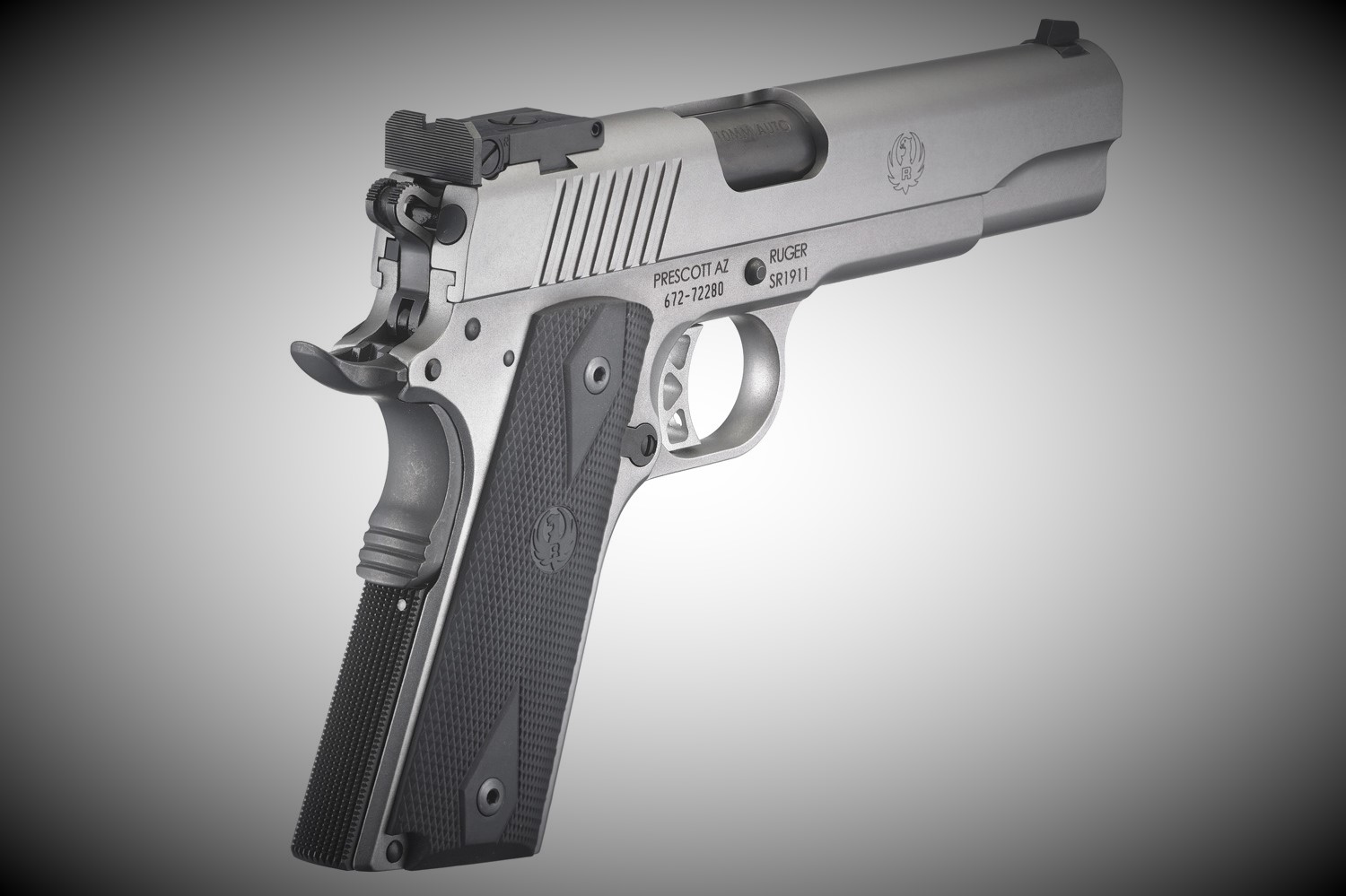
The sights are target-type sights with nary a dot to guide you. The rear Bomar-style, fully-adjustable target sight is serrated to cut glare. A good set of night sights would outfit this pistol for defensive use very nicely, but would mitigate the capability of adjusting the sight for various loads for those who like to ‘roll their own.’

The thumb safety is extended and black for contrast. It is also left-side only, which follows the original 1911 design.
The SR1911 10mm pistol is outfitted with a “Commander” style skeletonized hammer, as is common these days. Just below that hammer is a nicely beaver-tailed grip safety with memory bump that allows the hand to get as high as possible on the grip. An all metal and checkered mainspring housing follows the grip safety.
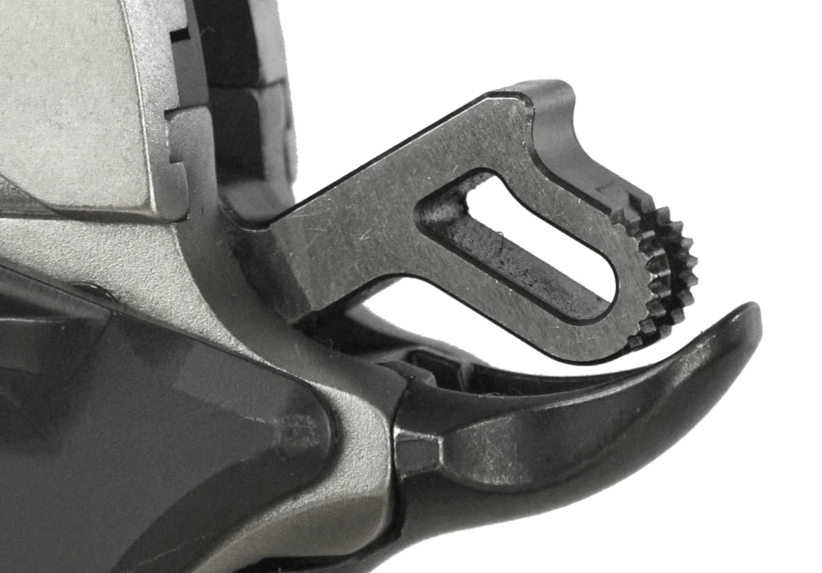
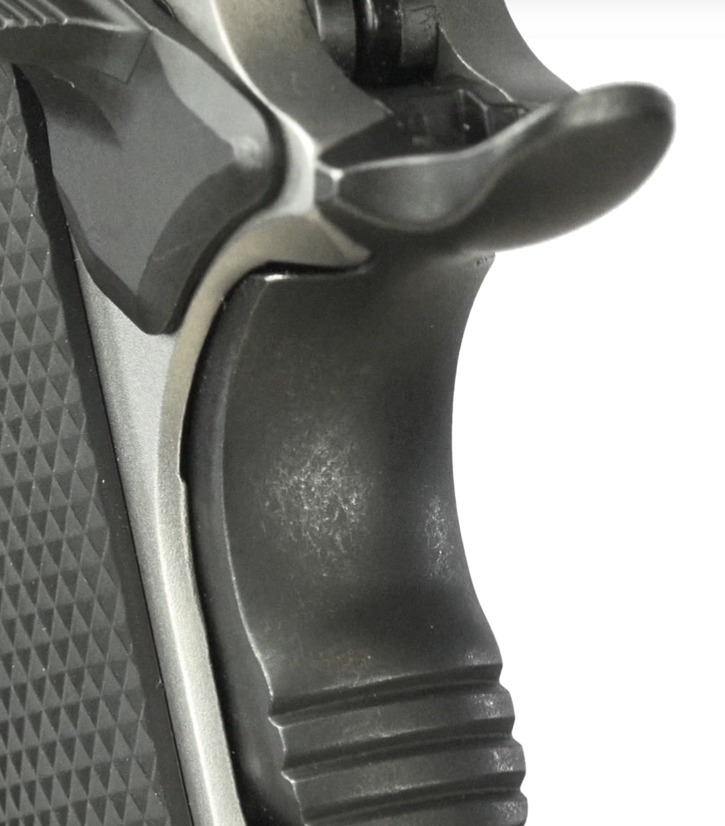
The SR1911 in 10mm, like all Ruger SR1911 models, incorporates an integral Plunger Tube assembly rather than a staked-on assembly like other 1911 pistols. What this means is that you never have to be concerned with a loose staked-on Plunger Tuber assembly or one coming off the pistol along with the associated spring and plungers.
The grip panels are black rubber that add some grip texture, which this pistol needs, as the front strap is not textured at all. This pistol received the Hogue Rubber Finger-Groove Wraparound grip treatment first thing. This pistol is a ‘practical-tactical’ pistol, from my viewpoint, and the Hogue grips have proven their worth to me.
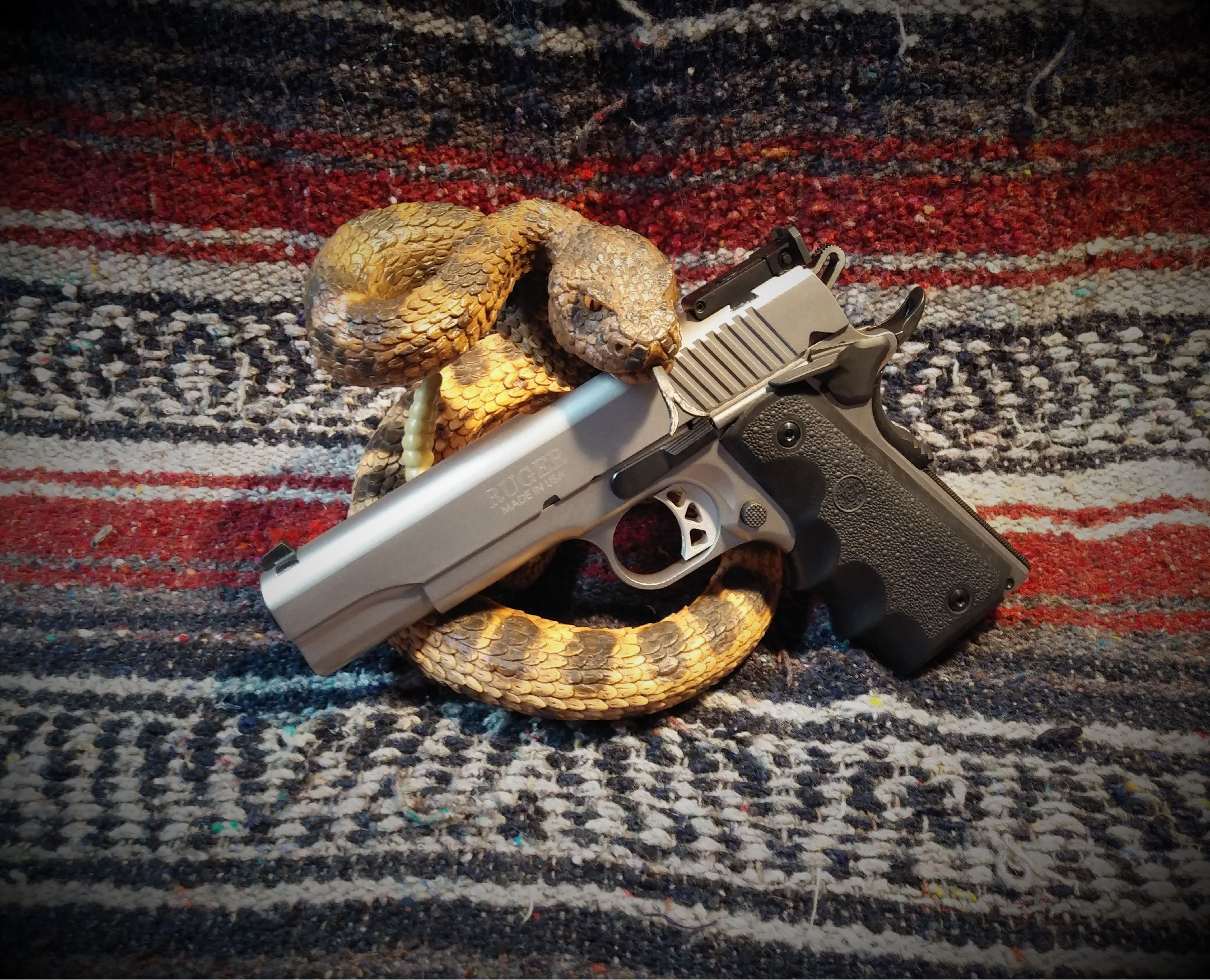
Ruger SR1911 10mm with Hogue Rubber Finger Groove Wrap-a-Round Grips Installed.

The trigger is the now common long-reach skeletonized aluminum trigger with over-travel adjustment. The trigger exhibits extraordinarily little take-up, a clean break at around 5.9 pounds (according to a 5-pull average on my Lyman Digital Trigger Pull gauge) when brand new and out-of-the-box, and no over-travel. Reset is quick, as expected from a 1911 pistol. I expect that the trigger pull weight will lessen and smooth out after use.
The two provided magazines are 8-round flush-mounted with no bumper pad and are Ruger stamped. Running 9-round Wilson Combat magazine with bumper pads as spares, or as the primary magazine, would be a better option and several have been placed on order from Cheaper Than Dirt (the best price so far).
In appearance, the SR1911 10mm Auto pistol has somewhat of a passive-aggressive look about it. Obviously, I am not referring a personality disorder, but simply that the pistol has a passive look to it while the caliber fired is anything but passive with its comparison to the average .357 Magnum load and below standard .41 Magnum rounds.
The Ruger SR1911 in 10mm is an excellent looking pistol and feels just as excellent in the hand. At 40.4 ounces (2 pounds 8.4 ounces) dry and 46.40 ounces (2 pounds 14.2 ounce loaded (9 rounds), it is not the lightest pistol in the world, but the weight is a positive thing and Ruger does an excellent job of balancing the pistol with the 10mm ammunition from which it shoots, although without a loaded magazine installed it does feel barrel heavy.
Pre-Flight
Prior to hitting the range, a “pre-flight” inspection and lubrication is warranted not only for the first time, but every time.
Since the Ruger SR1911 10mm has a full-length guide rod, disassembly and assembly is a bit different from a conventional 1911 pistol.
Ruger provides a funny-looking bent pin that is used to secure the guide rod. However, I do not like funny-looking bent pins rubbing against the front of the slide. I have found some fiber washers that will slip over the guide rod. I then insert the pin and continue with the disassembly/assembly from there. So, I am going to add a step to the original Ruger disassembly procedure that follows;
- Keep the pistol pointed in a safe direction and your fingers outside of the trigger guard. Press the magazine catch and withdraw the magazine from the butt of the pistol.
- Pull the slide to the rear and lock it open by pressing upward on the rear end of the slide stop. Check the chamber and breech face to verify that the pistol is completely unloaded.
- Slide a thin fiber washer over the end of the guide rod and press it against the front of the slide.
- Insert the wire tool into the hole of the guide rod/recoil spring assembly. NOTE: The wire tool is used to hold the recoil spring at its compressed length so that the guide rod/recoil spring assembly can be removed from the slide.
- Apply rearward pressure on the slide to release the slide stop, then move the slide forward to align the takedown notch in the left side of the slide with the rear portion of the slide stop.
- Press inward on the slide stop pin from the opposite side of the frame and remove the slide stop.
- Move the slide forward off the frame. Turn the slide bottom up and remove the guide rod/recoil spring assembly. To do this, move the guide rod assembly upwards and away from the barrel, towards the rear of the slide.
- Rotate the barrel link to the forward position and remove the barrel through the front of the slide.
- To separate the recoil spring from the guide rod, insert the recoil spring/guide rod assembly back into the slide. NOTE: It may be helpful to place the rear of the slide on a gun mat and push downward on the recoil spring/guide rod assembly with the palm of your hand while using the other hand to stabilize the slide. Apply enough pressure to the assembly so you can remove the wire tool.
- Back the recoil spring/guide rod assembly out of the slide while maintaining control as the spring is under high tension and can fly out and cause injury.
- You can now separate the recoil spring, plug, and guide rod.
If you have disassembled/assembled 1911 pistols, this should be old hat to you. For newcomers to the 1911 pistol, I recommend that you refer to the Owner’s Manual and follow the instructions.
If you did everything right for pre-flight, the pistol should be duty-ready at this point. Let’s see how it did at the range.
Range Work
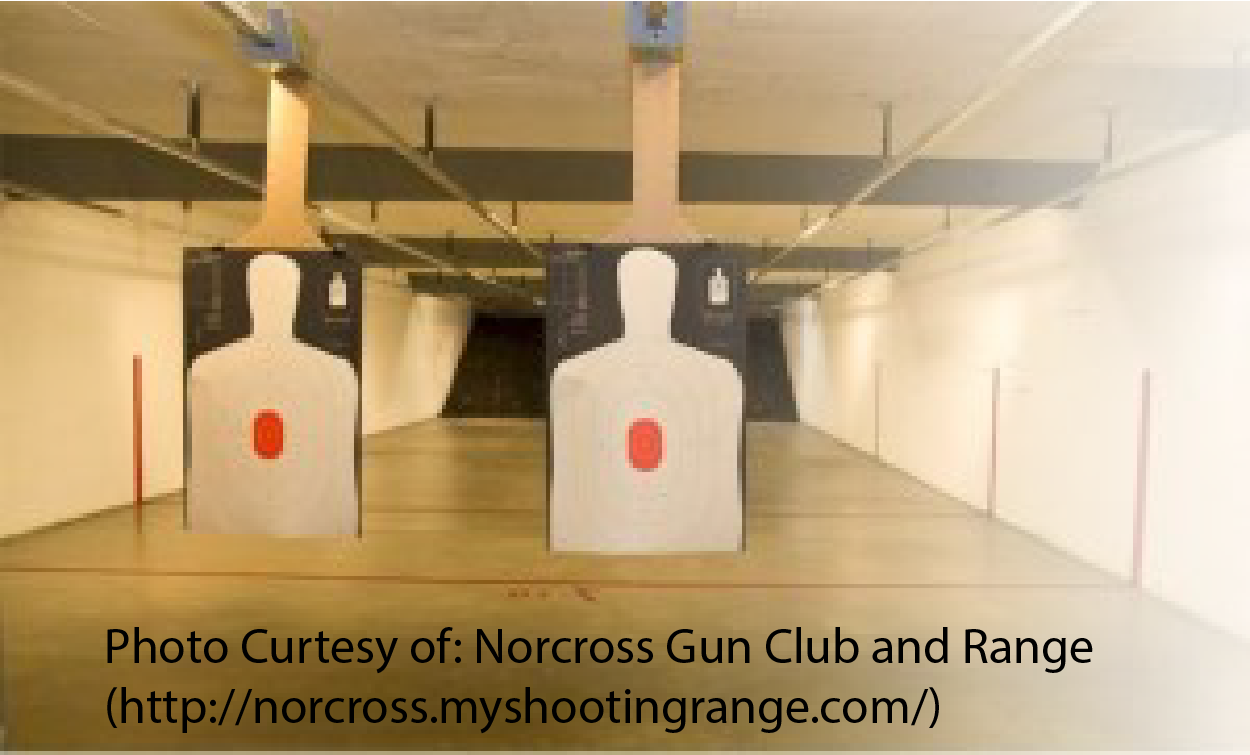
The Sellior and Bellot 180-grain FMJ, rated at 1150 feet per second would serve as the evaluation fodder for this range session. If all went well, I would follow up with some Sig Sauer V-Crown 180-grain JHP (1250 fps) to see how well the SR1911 10mm would function with defensive ammunition.
The initial distance was seven yards with a silhouette target staring me down. I knew that I had to send some bullets its way.
The initial zero check (seven yards, 5-rounds) to verify POI and POA went without incident, after some slight moving of the rear sight to the right. Then, I ran a few “Mozambique Drills” at ten yards to get a better feel of the recoil and handling characteristics of the Ruger SR1911 in 10mm. Surprisingly, the SR1911 is agile getting those rounds into the target. Although the felt recoil is sharp, a tad more than what I feel with the .45 ACP, it is highly manageable if I do my part. The weight of the SR1911 does help in recoil management, the Hogue Rubber Finger-Groove Wraparound grip helps my shooting hand to stay in place and having a high grip on the handle helps me to push that muzzle back down relatively quickly. I found that I could run the “Mozambique Drills” almost as fast as I can with the 1911 in .45 ACP chambering (which is not fast, by the way). As compared to the 1911 running 230-grain fodder at 853 feet per second, or a 185-grain bullet at 910 feet per second, running a 180-grain FMJ at 1165 feet per second is a significant increase in velocity, energy, and felt recoil.
I can say that the bark of the Ruger SR1911 is as sharp as its bite. Felt recoil was sharp, as it should be, but no worse than shooting my beloved 230-grain .45 ACP fodder. Muzzle rise was also not an issue, as a good firm and high grip kept the muzzle down as much as possible.
While I did not mention it earlier, the mag well is slightly beveled to assist in getting the provided 8-round magazine, or an after-market 9-round magazine, quickly into place.
And speaking of magazines, I had absolutely no failures with the two 8-round magazines provided by Ruger. The Wilson Combat 9-round magazines; however, gave me fits with multiple Failure to Feed issues. Initially, the first round of the magazine would not even chamber, with the cartridge hanging up on the feed ramp. I set the magazines aside and continued on the the Ruger magazines.
I retried one of the Wilson Combat magazines later in the session. The first round would chamber but the second round would not. It seemed that the cartridge was hanging up on the extractor. After clearing the malfunction, the rest of the magazine emptied as it should. However, running the same magazine again, it would intermittently not chamber a round. I finally attributed this to a break-in issue, ran out of time, and decided to run the magazines at a later time as I continue to break in the firearm.
Getting the rounds on target is half the battle. What those rounds do after they impact the target is left to science.
I can say that the Ruger SR1911 in 10mm flavoring is accurate and reliable at this point. Wilson Combat magazine issues notwithstanding, the SR1911 in 10mm is an excellent shooting pistol. All that shot it this day agree.
Lastly, the Ruger SR1911 10mm and the Sig Sauer V-Crown 180-grain JHP is an excellent match up, as the ammunition resulted in several good, combat-accurate 5-round groups when fired offhand.
Magazine Dependent
I am finding that the Ruger SR1911 in 10mm favoring is magazine dependent. Of the two magazines shipped with the pistol, I have had only one FTF; otherwise, the magazines have performed flawlessly.
Aftermarket market magazines, Wilson Combat, Ed Brown, and Remington have posed a problem with FTFs…many FTFs. The Remington magazine have been the greatest offender, so far. The Wilson Combat magazines seem to be breaking in, but operation is sporadic.
At first, I could not tell what was happening. The rim of the cartridge seemed to be hanging up on the extractor, but a closer inspection revealed that it was hanging up on the slide material just below the extractor. Then, it was revealed that sometimes the round would chamber using the slide lock/slide release over the ‘slingshot’ method, but yet at other times the ‘slingshot’ method worked over using the slide lock/slide release. The round would bind up going into the chamber. Sometimes, the round would not be released fully by the magazine. I could see clearly that the rim of the cartridge was not hitting against the slide or the extractor. This was all disconcerting, to say the least.
As I stated, both magazines provided with the pistol seem to work simply fine and they, like the pistol, have not been broken in as yet.
As with ammunition, the right magazines for the pistol must be discovered and sometimes that takes a healthy investment with both ammunition and magazines, unlike the point-n-shoot interface of a revolver.
Other than suspected aftermarket magazine related FTF issues, the Ruger SR1911 in 10mm is one good shooting pistol. For me, it is a pleasure to shoot with the 10mm cartridge as it is with the .45 ACP cartridge. I would have no issue carrying the 10mm Ruger SR1011, although the 10mm cartridge has not been fully accepted as a cartridge used for self-defense. In that vein, I would rather carry the 9mm or the .45 ACP, with the latter being my preferred cartridge. However, the 10mm cartridge, at least the ones that I was shooting, exhibit less felt recoil than the 1911 with 230-grain loadings, and a 180-grain rated at 1125 fps (Sig Sauer V-Crown 180-grain JHP) is no slouch, I would consider carrying this combination of pistol and cartridge for defensive purposes – if the pistol and magazines show 100% reliability .
UPDATE 10/12/2019
After taking a short break from the Ruger SR1911 10mm and its magazine issues, I had to return to the issues, evaluate a couple of different magazines, and determine if the SR was going to remain in the stable.
I had ordered new magazines during the downtime; two Ruger, two Metalform (which I suspect is what Ruger is using), and two MEC-Gar in an attempt to see if the magazine issue would disappear, which I believed it would.
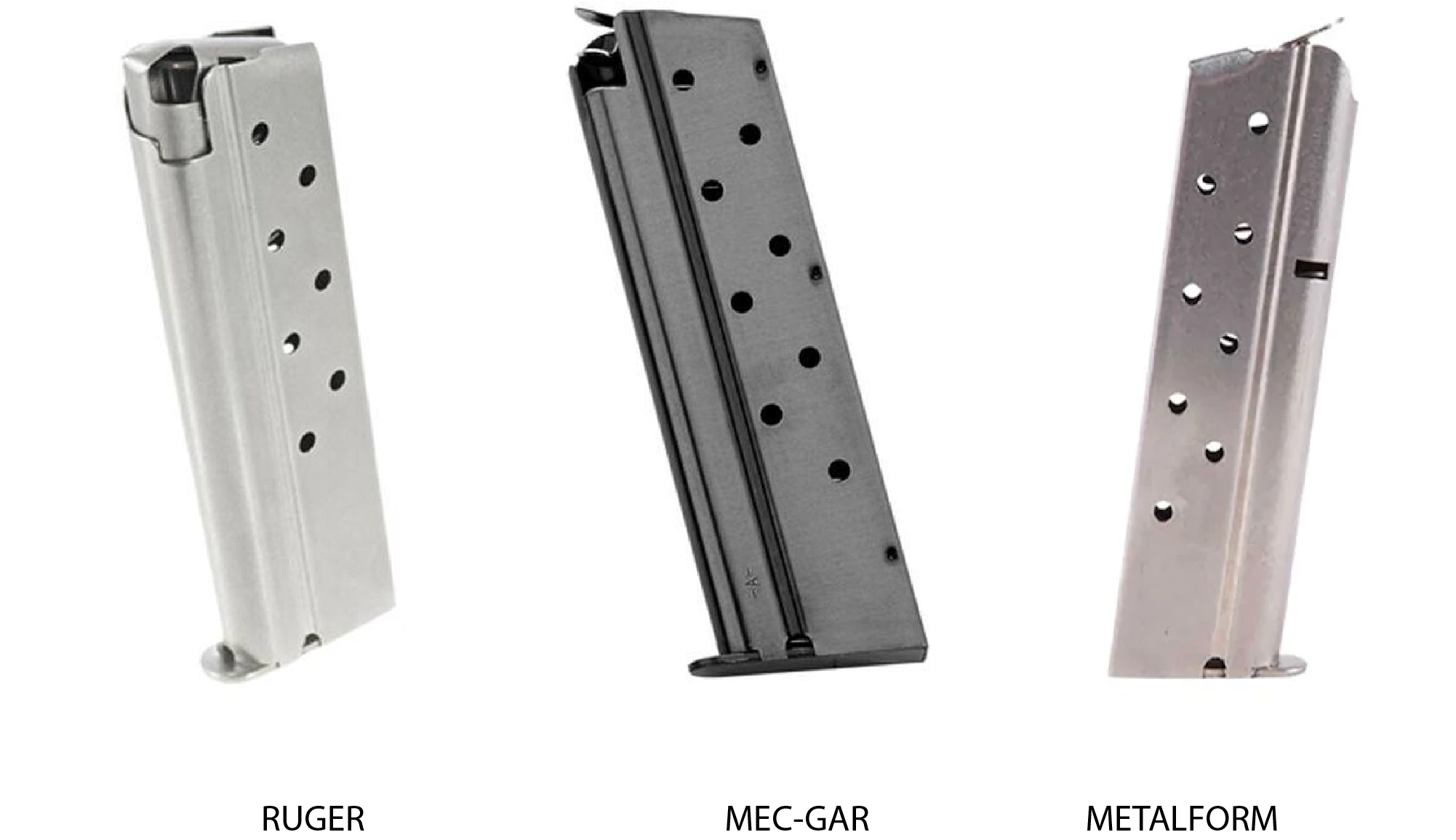
First up was the Ruger magazine. As with the magazines that came with the pistol, the Ruger magazine performed exceptionally well with no FTFs.
The Mec-Gar magazines also performed well.
The Metalform magazines, as I had suspected, performed like the Ruger magazines, as the construction of these magazines is identical to those used by Ruger. At over a $10 price difference between the Ruger and the Metalform magazines, the Metalform magazines win out due to cost.
Wilson Combat magazines, which provided multiple FTF issues worked this time around with no issues.
I still cannot answer why the Ed Brown, and Remington magazines would and will not work in this pistol. The short to all of this is that Ruger, Metalform, Wilson Combat, and Mec-Gar magazines worked without failure with the Ruger SR1911 in 10mm. The initial issues could have simply been break-in problems that resolved themselves over time and use. At this point, I can fully rely on the Ruger SR1911 in 10mm to function with 100% reliability using Ruger, Mec-Gar, Wilson Combat, and Metalform magazines.
Update 12/04/2020
I just knew that I could not let things alone. Although the Ruger 10 received the Hogue Rubber Finger-Groove Wraparound grip treatment first thing, I wasn’t satisfied to leave things alone. A set of Altamont finger -groove 1911 Govt. Super Walnut Checkered Fleur-de-lis panels were installed. I felt that the plain stainless steel mounting screws mated with the finish on the frame and slide well enough not to replace them.
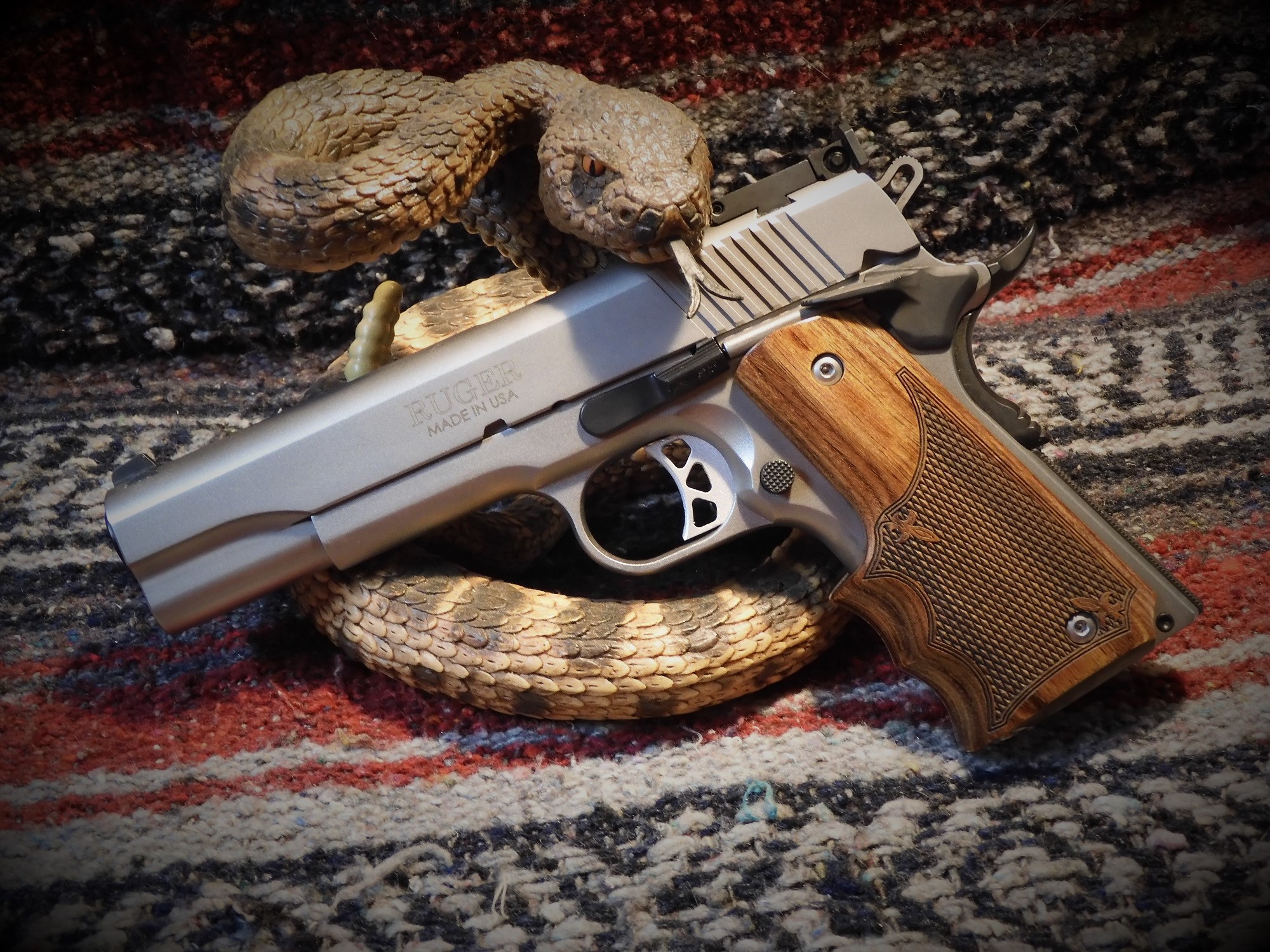
The grip panels, while still retaining the feel that I like in a 1911 grip, add a touch of class that rubber just cannot even come close to. It’s not like the Ruger 10 is going on a lot of woods-walks. And, even it was a woods companion, the laminated panels are enough to keep the elements at bay.
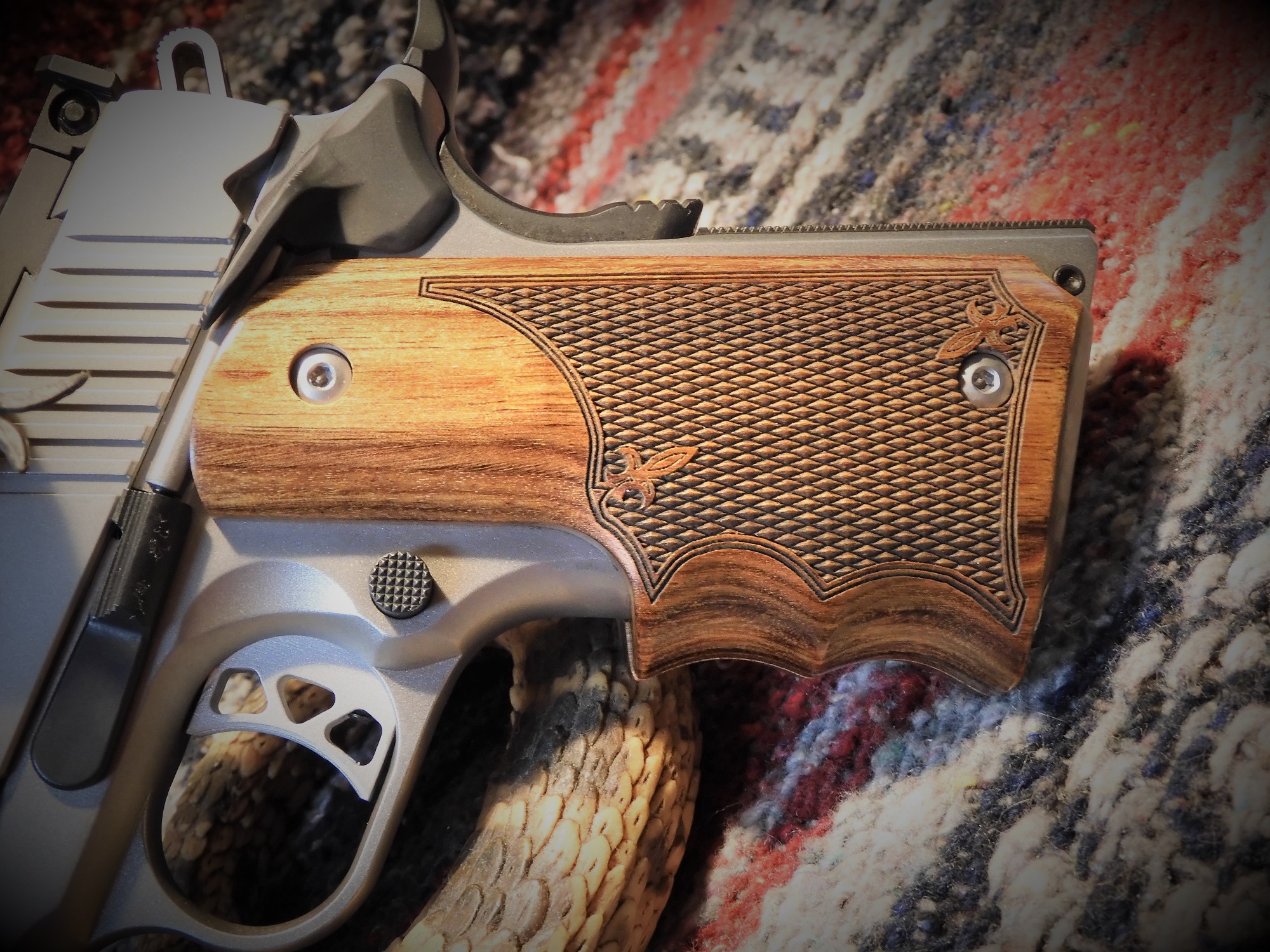
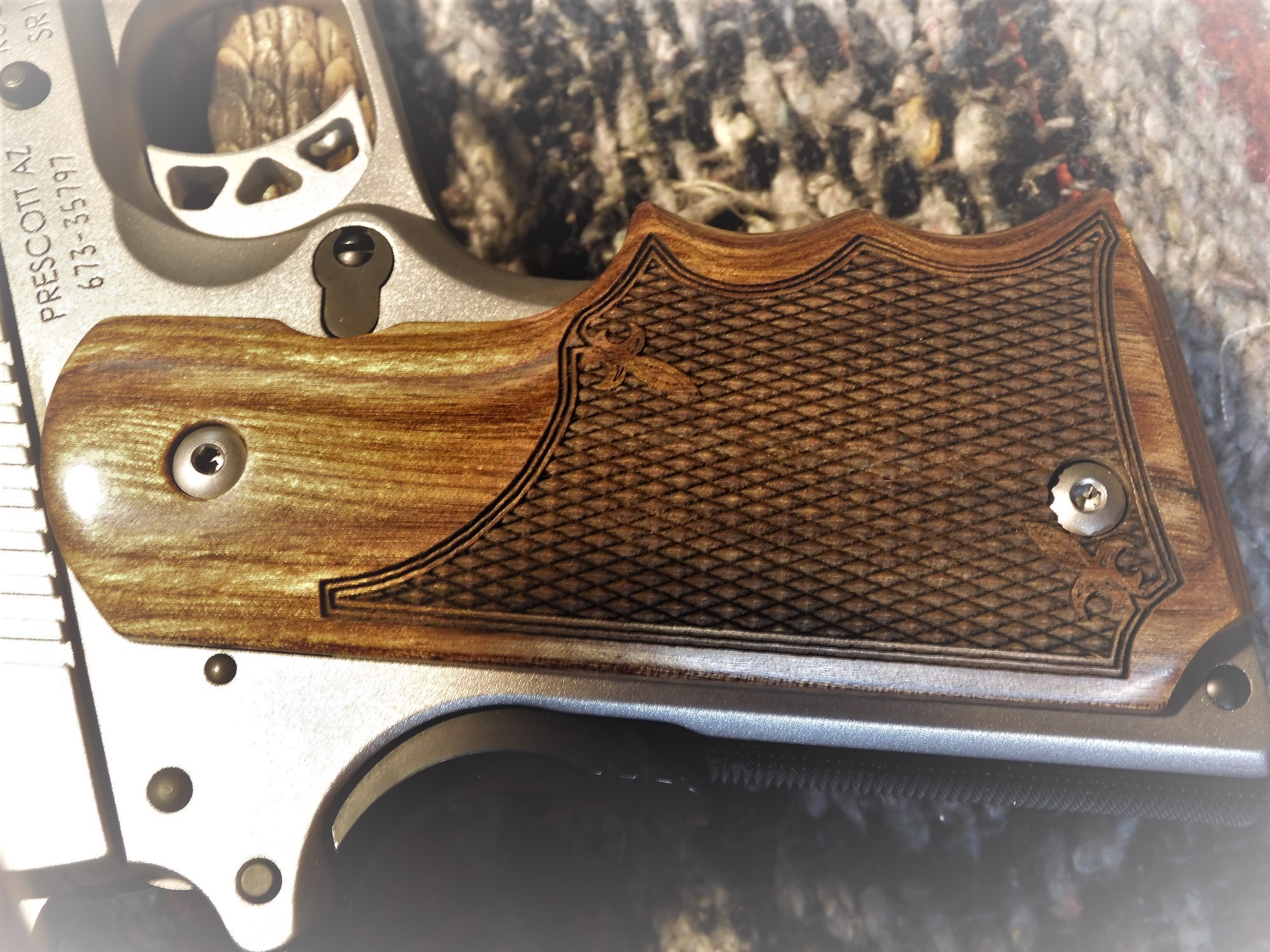
The mild checkering is comfortable against the hand yet provides a good gripping surface. The grooves , it would seem, were molded to my hand. The grip, like the Hogue finger-groove grips, add some dimension to the front of the grip. These grips may not work well for those with small hands or short fingers, but my hands welcome them.
Update 12/14/2020
One last update to round things out…literally. Replace the flat mainspring housing with an arched unit.
The standard Ruger SR1911 10mm flat mainspring housing was replaced with a Hogue 01370 Colt 1911 Government Mainspring Housing, Aluminum Checkered Arched Matte Black Anodized. Coupled with the Altamont set of finger-groove hardwood grips, the pistol now fits my hand like it was made for it. The Hogue arched mainspring housing is checkered rather than serrated like the standard Ruger unit. That provides me with more confidence when holding the pistol that, I hope, translates into better accuracy with the pistol. The results of the mainspring housing update is shown the images that follow.
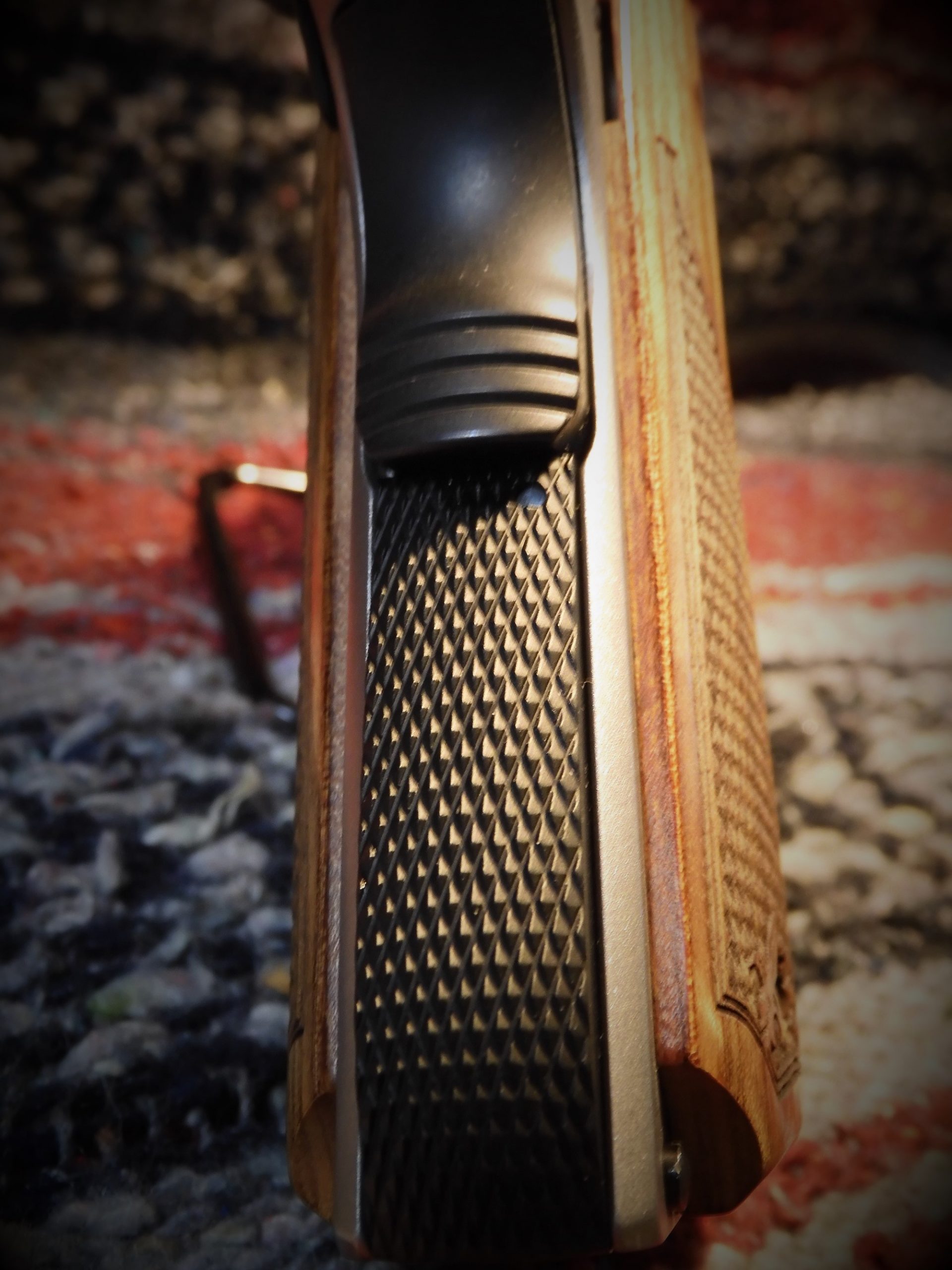
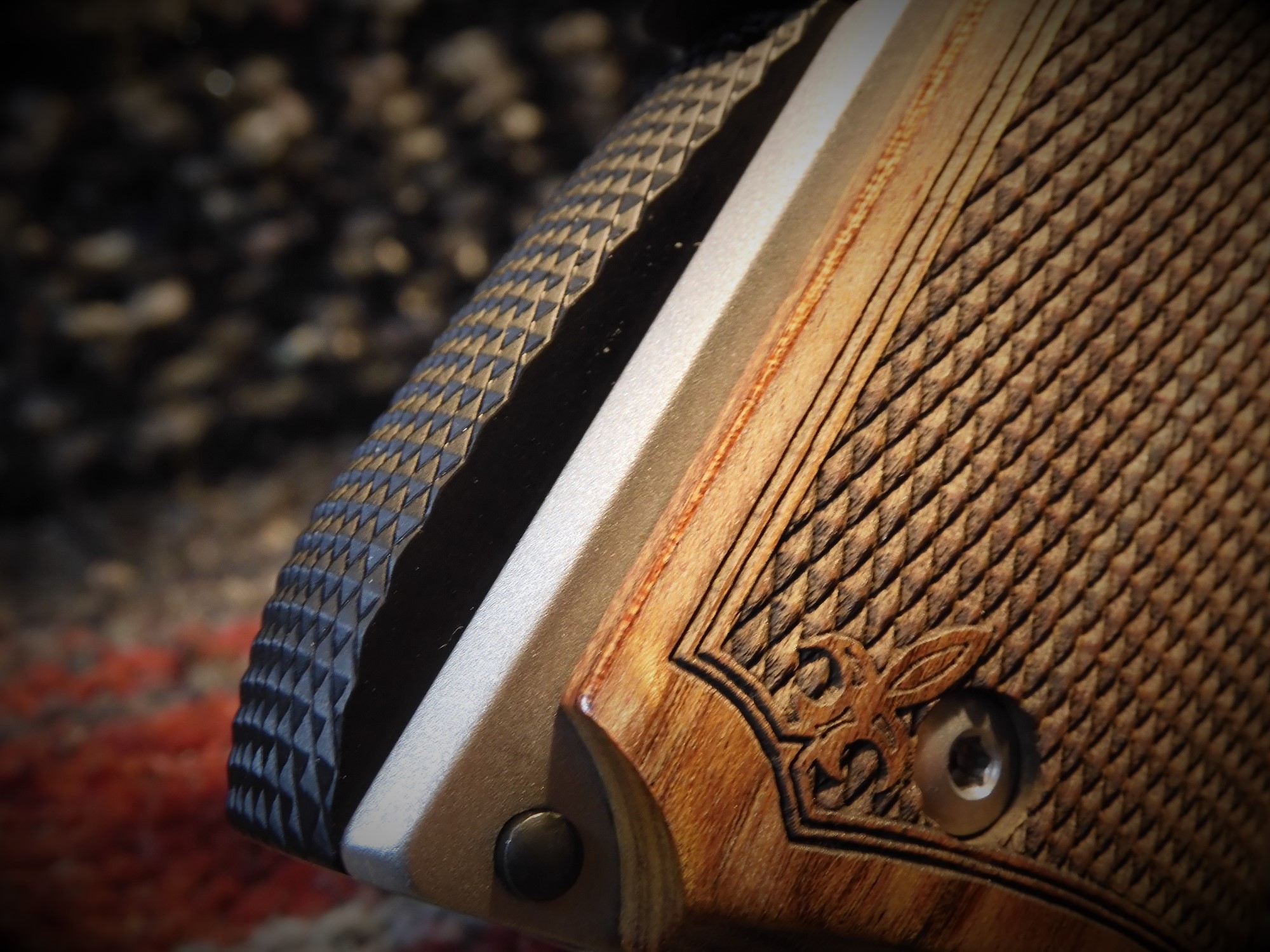
Color matching with other Ruger controls on the pistol is near flawless. The checkering of the arched mainspring housing also matches that of the Altamont grips.
I can see more orders going out for the Hogue arched mainspring housing in the future for other 1911-bsed pistols.
The Concealment Factor
A full size 1911-based pistol lends to a degree of difficulty for concealment of the pistol. However, with the proper holster and attire the Ruger SR1911 can be effectively concealed if you do your part. I have been using an A112 Hawk holster from Falco holster lately, and it does a fine job of housing, protecting, and concealing any 1911-based pistol. The A112 Hawk holster from Falco is a leather holster that is more friendly to your pistol’s finish. If you don’t mind the accelerated wear on your pistol’s finish from a “Kybrid” holster, the ALIEN GEAR CLOAK TUCK 3.5 IWB HOLSTER (INSIDE THE WAISTBAND) FOR 5” 1911 just might work for you.

Ruger SR1911 10mm in a FALCO A112 Hawk IWB Holster
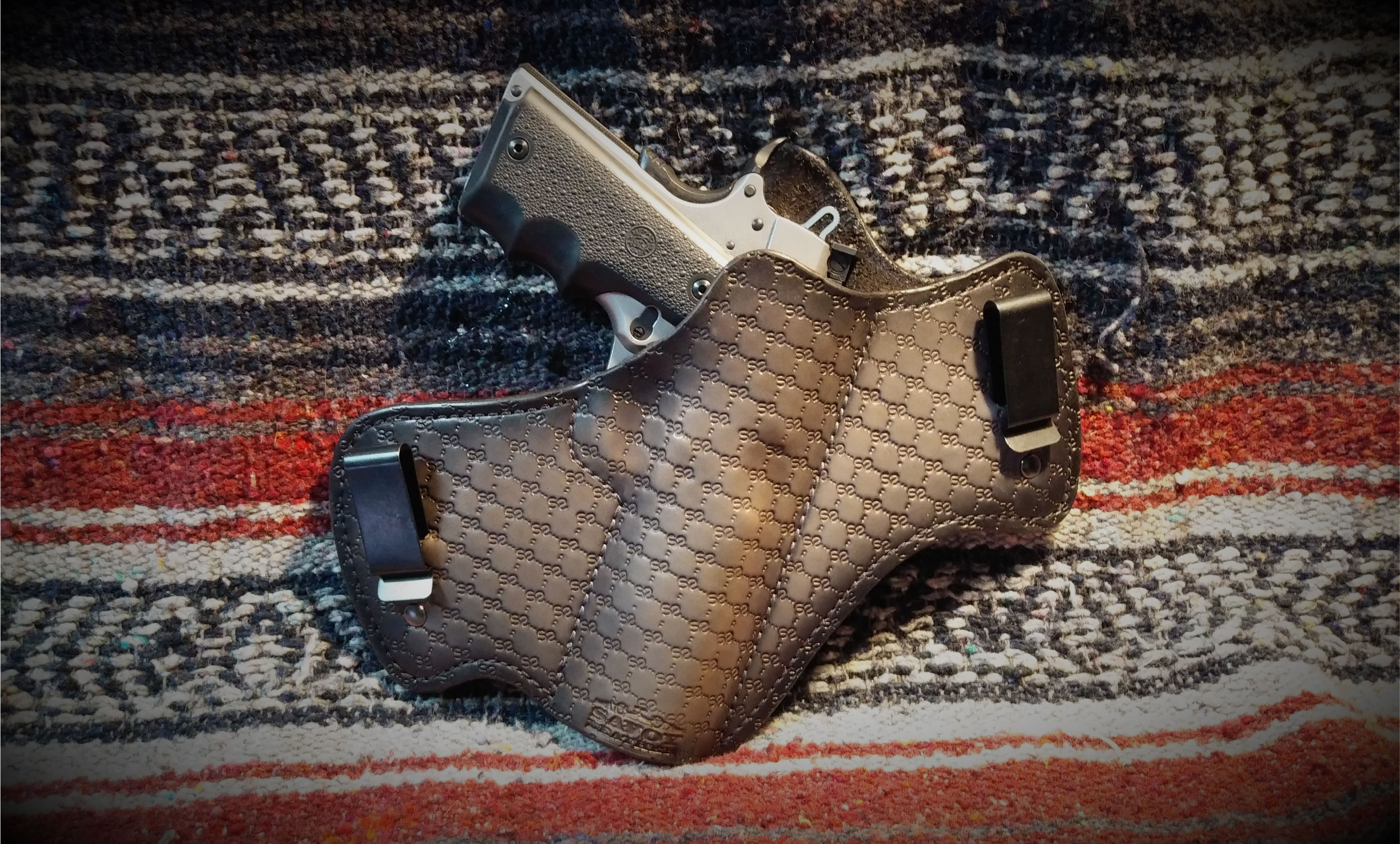
Ruger SR1911 in a Custom IWB Holster from SAVOY Leather.
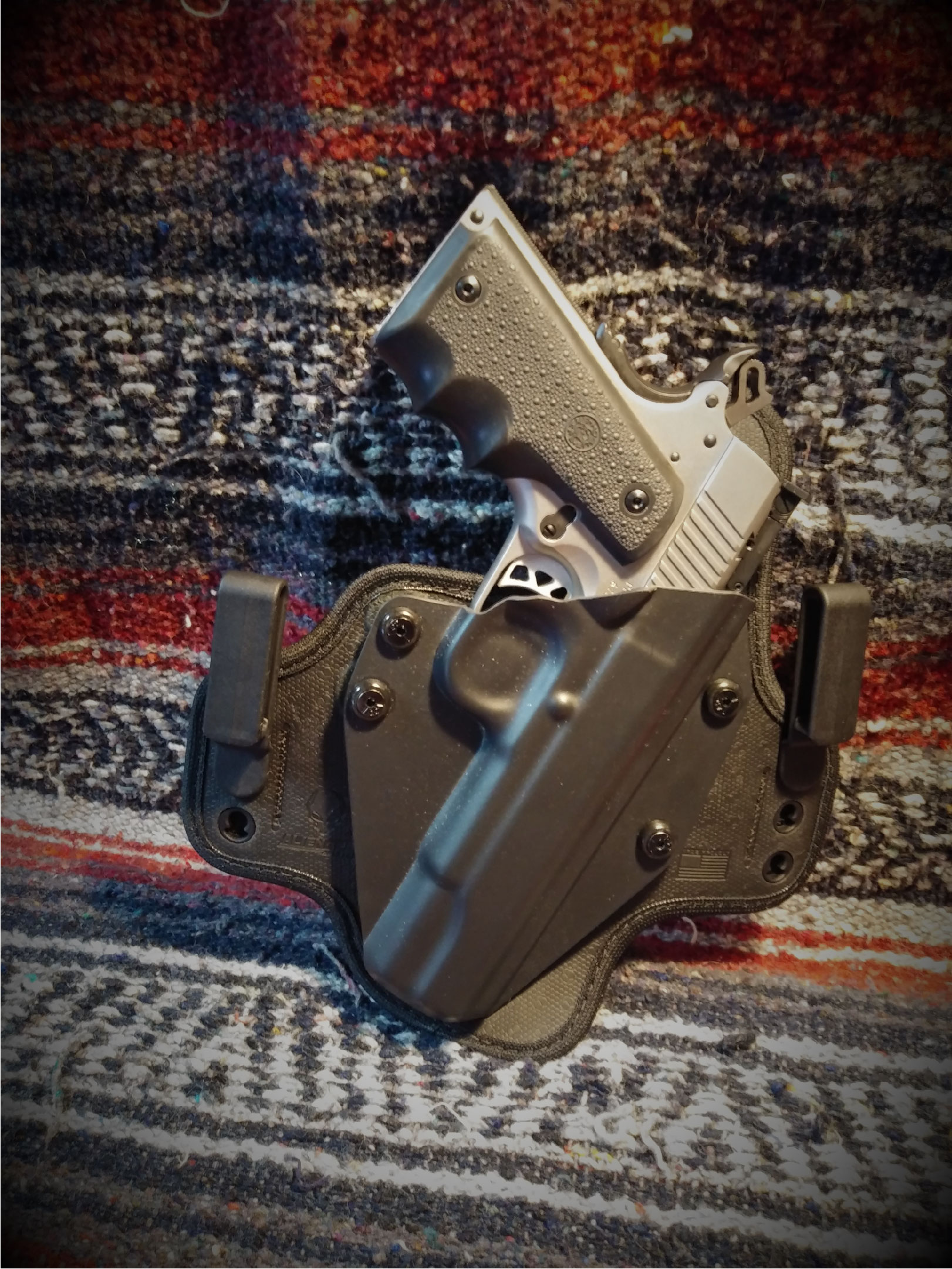
Alien Gear Cloak Tuck 3.5 IWB Holster for the 1911
Although I am not a fan of “Kybrid” holsters, some folks are. The Alien Gear Cloak Tuck 3.5 IWB Holster for the 1911 would be an excellent choice of holsters.
Summary
I was not sure of how this adventure with the Ruger SR1911 in 10mm Auto was going to turn out. Would it stay or would it go?
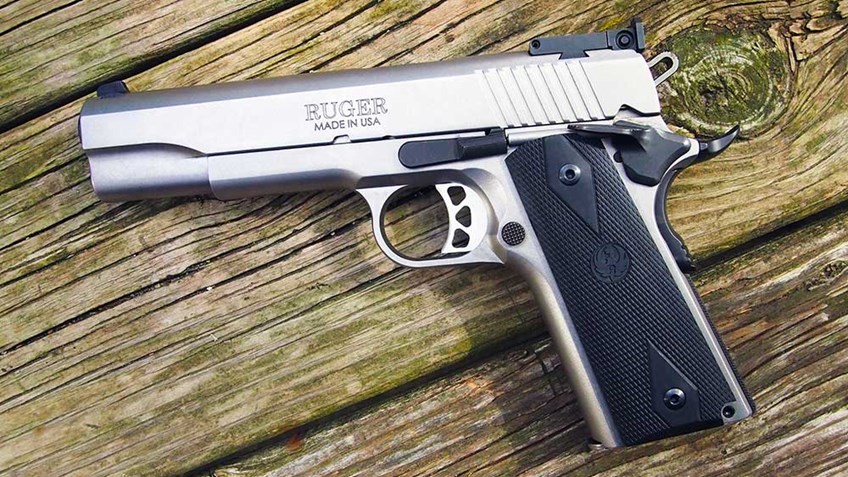
From all indications, so far, the Ruger SR1911 in 10mm Auto is a keeper.
It handles 10mm defensive ammunition (Sig Sauer V-Crown 180-grain JHP at 1250 feet per second) very well, is more than accurate and adequate for a defensive pistol, felt recoil is manageable, and the 1911 platform is very familiar to me. The Hogue Rubber Finger-Groove Wraparound grip helps me in the grip girth department, which means better control of the pistol (at least in my hand).
Of course, there is the question of longevity of a pistol when firing ammunition like the 10mm, but since I will primarily be firing target ammunition, the wear and tear on the pistol should be negligible and will be monitored as the pistol is put into use. From what I can tell and knowing Ruger’s commitment to quality and building strong firearms, the pistol will outlast me. Only time and use will tell. Shooting down-loaded 10mm ammunition should not have any ill effects on this pistol whatsoever.
Should you be in the market for a 10mm semiautomatic pistol, the Ruger SR1911 in 10mm Auto may just scratch your itch for an excellent, modestly-priced pistol.
Resources
- Ruger Model Number: 6739, 10mm Auto: https://ruger.com/products/sr1911Target/specSheets/6739.html
- Ruger SR1911 10mm (HICKOK45): https://www.youtube.com/watch?v=8qNw108olqg
- Shooting Ruger’s NEW SR1911 Semi-Auto 10mm Pistol – Gunblast.com: https://www.youtube.com/watch?v=PqiXg0xGvfs
- Ruger’s NEW SR1911 Semi-Auto 10mm Pistol: https://gunblast.com/Ruger-SR1911.htm
- The 10mm Is Making A Comeback: https://www.youtube.com/watch?v=_j-zBhThsEk
- Ruger SR1911 in 10mm!: https://www.youtube.com/watch?v=ekyKmLM7Oa4
![]()

